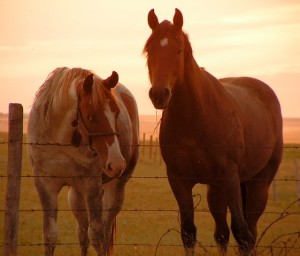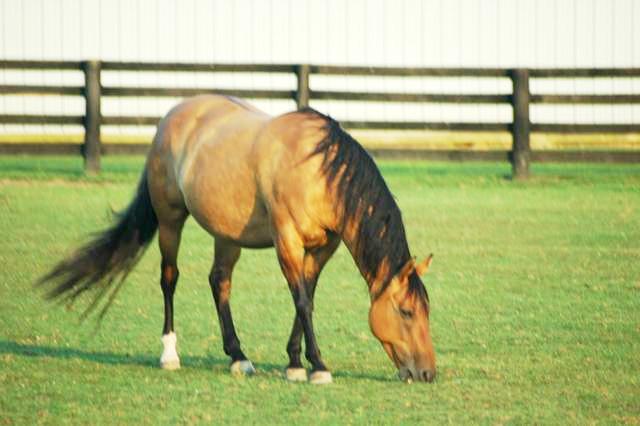 Here’s a point to ponder for all of you horse lovers out there: Don’t get so horse crazy that you lose all common sense. Getting caught up in your enthusiasm and passion for horses can easily overshadow some basic truths that I would like to point out.
Here’s a point to ponder for all of you horse lovers out there: Don’t get so horse crazy that you lose all common sense. Getting caught up in your enthusiasm and passion for horses can easily overshadow some basic truths that I would like to point out.
1. No horse is worth getting hurt badly for.
I know of so many horse people who believe contrary to this, and have personally missed this concept several times and misjudged my own abilities. Take, for instance, one of my first cowgirl memories…
I was five years old, working cattle with my big sister Kandra and my Dad. I was riding our good old steady ranch horse Chigger, Kandra was on her barrel gelding Apache, and my dad was training a 3 year old colt named Kokomo. We had been riding all day, gathering cattle, and had brought them up to some holding pens to sort out some cow-calf pairs to take to summer pastures. It was long tedious work, and we were probably short on help, me being just five years old, and my dad’s horse being so inexperienced. As the sun started to go down, I began to complain that I was cold. So my dad took me to the pickup, and said they wouldn’t be that much longer, and for me to not get out of the pickup. His colt was tired and sweaty, so he swapped saddles with the horse I was riding, and left Kokomo in the trailer, which was hitched to the pickup I was sitting in.
I sat in the pickup, trying to warm up, and it was almost dark when there was a loud crash from the trailer, and then a series of stomps and banging and the whole pickup started shaking. I didn’t know what was wrong with the colt back there, but I began to be concerned that the pickup was going to tip over. (Remember, I was five.) So I got out of the pickup.
Climbing up on the side wheel well of the trailer, I looked in and saw that Kokomo had gotten his halter caught on the middle door latch of the trailer and had pulled the door shut, and he was stuck with his head caught up against the corner of the door, his feet thrashing and lashing as he tried to free himself. I was certain I could help. So I hung on the trailer latch release lever with all of my weight, and as it opened, I reached in with my left hand to pull his halter free of the latch. Somehow, the latch slipped shut right on the fleshy part of my forearm.
Kandra said I was screaming my head off (I don’t remember it) and they came racing up to see me clutching my arm and bleeding. Leaving the cows, we raced home, put my arm on ice, and drove to the emergency room for about 29 stitches in two places on my left arm. I still have a big scar from it.
Now, granted, I was only five years old and should have obeyed my father and stayed in the pickup or not be allowed to even be around horses. But it’s no different from a teenage girl I heard about who went into a stall to help a stallion that had panicked, and he struck her in the head and she died. The simple truth is: if a horse is in a bad situation, stay away from it. You cannot help things by going into a dangerous place and trying to help. Let the horse calm down, or get someone to help you, and come up with a safe way to alleviate the problem.
I also see people who think they can help a problem horse, and they take it upon themselves to train it, and end up on crutches for the next ten weeks while the horse gets labeled as a killer. The same principle applies here. Understand that no matter how enthusiastic you are, there are some horses that you just shouldn’t mess with. Know your limitations, and don’t be afraid to say, “No thank you. This isn’t the horse for me.” There are millions of horses in the world, and not one of them is worth getting put in the hospital or permanently injured for.
2. No horse is going to live forever, nor does every horse merit a long life.
This is another point that a lot of horse lovers are in denial about. I may lose some friends here, but I’d like to address the unwanted horse issue, and share some overlooked facts about the overall condition of horses today, as opposed to five years ago when there were still a few legally operating horse processing facilities in the United States.
I personally have been watching at the local auction barns. Just last week, I saw a big sorrel gelding come through the ring—five years old, green broke and started riding, well-cared-for and finely muscled, calm and responsive in the ring—and he brought $85. A few weeks before, I watched a glossy three year old cremello gelding that had been blanketed and shod sell for $100. I don’t know whether they went to a good home or a truck bound for Canada. But these horses would have brought at least a thousand dollars just a few years ago, and certainly would have gone to a 4-H kid or a project for a local trainer, because they had value as horses. What has changed?
Several things have contributed to the devaluation of the horse. In 2007, the last remaining U.S. slaughter plants closed as a result of legislation making it illegal to slaughter a horse for human consumption in those states. This resulted in horses being shipped to Canada and Mexico, which made transportation costs much higher, and therefore limiting the amount kill buyers were willing to spend on a horse. Also, the poor economy, rising veterinary care costs, higher prices on fuel, hay, feed, and land have limited horse owners and forced them to sell or give away horses they could no longer afford. The horse has become a luxury item, and it’s not as easy to own one, so there’s no demand for horses—not even good horses—anymore.
As a result, we have horses being abandoned in muddy pens because the owners can no longer buy feed for them. We see entire ranches of horses seized because of neglect (remember the Three Strikes Ranch in Nebraska?) and rescues in every area are full to capacity and taking in more horses every day. We’ve seen a huge decrease in personal responsibility and the conscience to do right and care for your animals as you should in the last several years as well. And when the poor economy makes it impossible to keep a horse, no one but the kill buyer can afford one. The guy who brought that cremello to the sale barn had spent more in his last farrier visit than he got out of just selling the horse. So it’s forcing horse owners to get rid of their horses.
And that’s why I am pro-slaughter, as ugly as it may sound. The USDA had strict policies on the handling and transportation of horses to the processing plants, and there were regulations that ensured a horse a good way out. Now we’ve got them shipped to Mexico where there are no regulations at all! I think every horse deserves humane treatment, but not every horse merits a long life. If fate renders the horse useless due to injury, deformity, sickness, unmanagability, or unmarketability, then there ought to be a useful way to put the horse down and use the body for some good purpose. If the meat is eaten in a foreign country, I don’t see any reason why that’s a problem.
Common sense involves looking at the whole picture. Horses are as dear to my heart as anybody’s, but I can see how the horse industry has suffered over the last five or six years. People who are breeding indiscriminately and on purpose need to re-evaluate their goals. We need to put the horses we have to good use and stop breeding for no reason but to bring more foals to life to join the hordes of unwanted and un-useful horses we already have. I would be in favor of a well-regulated processing plant for horses that would put the meat and by-products to good use.
I have personally had a horse put down because of injury, a horse die of accidental causes, and a horse die of old age. Fortunately, two of the deaths occurred on my dad’s ranch, and we had a place where the bodies could be placed and nature took care of the rest. But one of them occurred when I lived in town and was teaching school on my own. I called a dead livestock removal truck company, and was informed that they would remove the body for $300, but there was no use for the meat. Regulations were so strict that it couldn’t even be used for dog food. So I had to pay someone to bring a tractor and bury it for me. It’s not the most pleasant subject in the world, but it’s reality, folks—and for all the horse lovers out there who like to pretend that horses live forever, it’s just not the case.
If we want to make a difference in the lives of horses, we need to start as close to home as possible. Care for the horses we own, reach out to a local rescue and volunteer, stop condoning overbreeding and indiscriminate reproduction, educate as many people as possible on the truths behind the slaughter issue, and work to bring back a balance in the horse industry. I would love to see every horse in the world have a happy home and a purpose, but I don’t live in a dream world. I know what it costs to own a horse, to pay vet bills for a sick horse, to have a horse die, and to see lawmakers make big changes without considering some key issues beforehand.
I don’t anticipate swaying anyone’s opinion from one side of the slaughter debate to the other. I don’t have that much clout. But I really think so many horse enthusiasts are misled and misinformed on the issues, and we all want the best for every horse in the world so we’ve jumped on the bandwagon for the side that seems to be protecting the horses. But don’t let your passion override your good sense. Every horse will die one day, and when we can no longer give a horse a good life, we need a profitable and useful way to end it.
Read some of these articles, if you are interested in more proof that we do indeed have a problem:
News Story About a Horse Turned Loose In the Desert
News Story About the Rise in Horse Neglect in the Midwest
New York Times Article on Reopening Slaughter Plants and the Rise in Horse Neglect
The Unwanted Horse in the United States – An Article by Tom Lenz


{ 1 trackback }